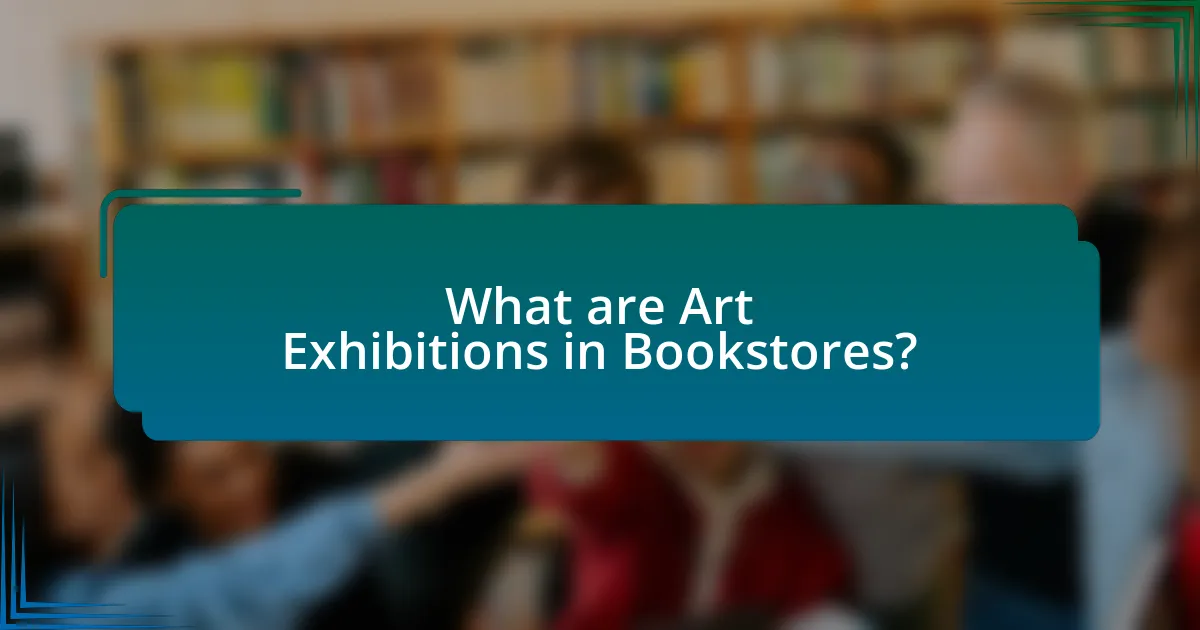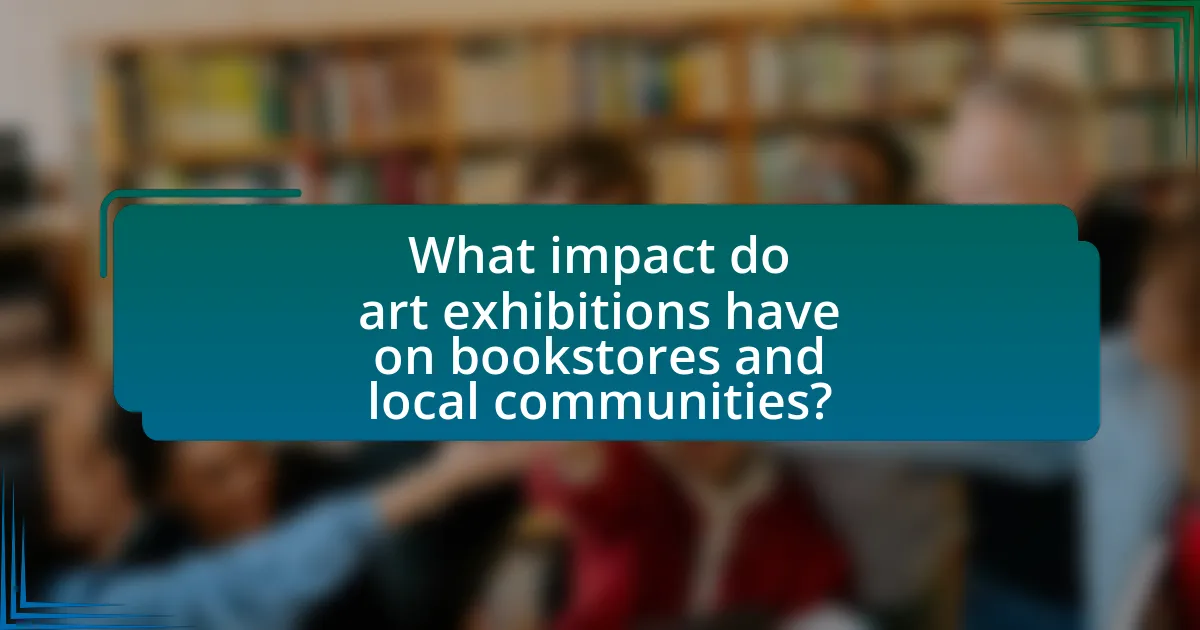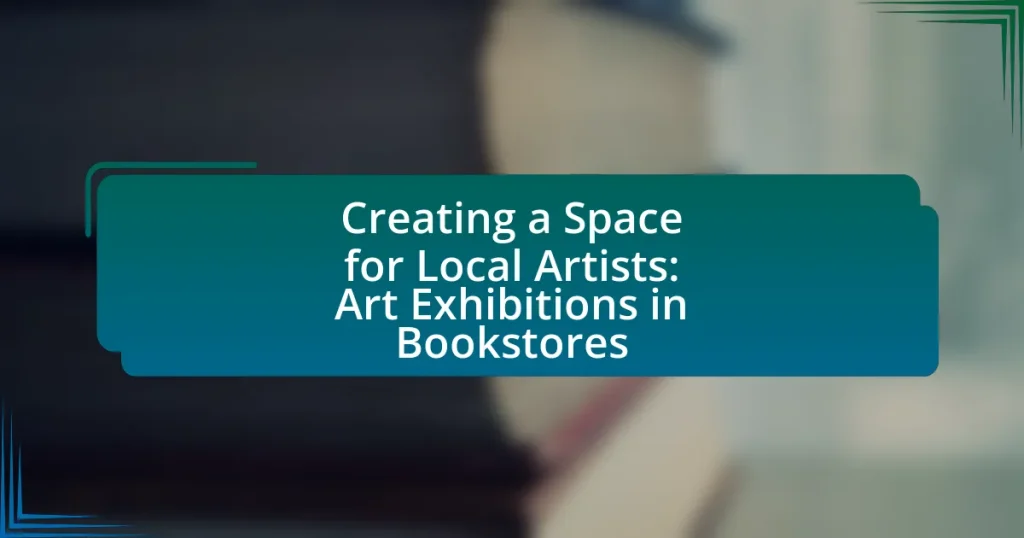Art exhibitions in bookstores serve as curated platforms for local artists to display their visual art, including paintings and photographs, within a retail environment. These exhibitions enhance the bookstore’s aesthetic appeal while fostering community engagement and support for local talent. Unlike traditional galleries, bookstores offer a more accessible and inviting atmosphere, encouraging interaction between artists and a diverse audience. The article explores the unique features of bookstores that benefit art exhibitions, the logistical considerations for organizing such events, and the mutual advantages for both artists and the community, ultimately highlighting the significant impact of these exhibitions on local culture and bookstore branding.

What are Art Exhibitions in Bookstores?
Art exhibitions in bookstores are curated displays of visual art that take place within the retail space of a bookstore. These exhibitions serve as a platform for local artists to showcase their work, often featuring paintings, photographs, and mixed media pieces. By integrating art into the bookstore environment, these exhibitions not only enhance the aesthetic appeal of the space but also foster community engagement and support for local talent. Bookstores that host art exhibitions typically collaborate with artists to create a unique cultural experience, attracting both art enthusiasts and book lovers alike.
How do art exhibitions in bookstores differ from traditional galleries?
Art exhibitions in bookstores differ from traditional galleries primarily in their accessibility and community focus. Bookstores often provide a more casual and inviting atmosphere, allowing local artists to showcase their work to a broader audience, including non-art enthusiasts who visit for books. This setting encourages interaction between artists and the community, fostering a sense of belonging and support for local talent. In contrast, traditional galleries typically cater to a more niche audience, often requiring a formal approach to viewing art, which can create barriers for casual visitors. Additionally, bookstores may host events like readings or workshops alongside exhibitions, further integrating art into the community fabric, while galleries usually focus solely on the art display.
What unique features do bookstores offer for art exhibitions?
Bookstores offer unique features for art exhibitions, including intimate settings, community engagement, and a diverse audience. The intimate atmosphere of bookstores allows for personal interactions between artists and viewers, fostering deeper connections with the artwork. Additionally, bookstores often host events that encourage community participation, such as artist talks and workshops, which enhance the visibility of local artists. Furthermore, the diverse clientele of bookstores, ranging from avid readers to casual visitors, provides a varied audience for artists, increasing the potential for sales and exposure. These features collectively create a supportive environment for local artists to showcase their work.
How do the environments of bookstores influence the presentation of art?
The environments of bookstores significantly influence the presentation of art by providing a unique, intimate setting that fosters engagement between the artwork and the audience. Bookstores often feature cozy, inviting spaces that encourage visitors to linger, which enhances the visibility and appreciation of art displayed within them. For instance, the layout of a bookstore can create natural pathways that guide customers past art installations, allowing for a seamless integration of literature and visual art. Additionally, the ambiance—characterized by lighting, decor, and the presence of books—can complement the themes of the artwork, creating a cohesive experience. Research indicates that environments rich in cultural stimuli, such as bookstores, can enhance emotional responses to art, making the presentation more impactful. This synergy between the bookstore environment and art presentation not only supports local artists but also enriches the cultural fabric of the community.
Why are local artists featured in bookstore exhibitions?
Local artists are featured in bookstore exhibitions to promote community engagement and support the local art scene. Bookstores serve as accessible venues that foster connections between artists and the public, allowing local talent to gain visibility and recognition. This practice not only enhances the cultural landscape of the community but also attracts customers to the bookstore, creating a vibrant atmosphere that encourages both art appreciation and book sales. Studies show that local art exhibitions can increase foot traffic and sales in bookstores, demonstrating the mutual benefits of this collaboration.
What benefits do local artists gain from exhibiting in bookstores?
Local artists gain increased visibility and access to new audiences by exhibiting in bookstores. Bookstores often attract diverse groups of customers, providing artists with the opportunity to showcase their work to individuals who may not typically visit galleries. This exposure can lead to increased sales, networking opportunities, and potential collaborations with other artists and local businesses. Additionally, exhibiting in a community-focused space like a bookstore fosters a sense of local support and engagement, which can enhance the artist’s reputation and connection within the community.
How do bookstores support the local art community through exhibitions?
Bookstores support the local art community through exhibitions by providing a venue for artists to showcase their work, thereby increasing visibility and accessibility. These exhibitions often feature local artists, allowing them to reach new audiences and engage with the community. For instance, many independent bookstores host monthly art shows or themed exhibitions that highlight the talents of nearby artists, fostering a collaborative environment. This practice not only promotes the artists but also attracts customers to the bookstore, creating a symbiotic relationship that benefits both parties. Additionally, bookstores may organize events such as artist talks or workshops, further integrating art into the community and enhancing the cultural landscape.

What are the key elements of organizing an art exhibition in a bookstore?
The key elements of organizing an art exhibition in a bookstore include selecting a theme, curating artwork, planning the layout, promoting the event, and coordinating logistics. Selecting a theme provides a cohesive focus for the exhibition, while curating artwork involves choosing pieces that align with the theme and resonate with the bookstore’s audience. Planning the layout is crucial for optimizing space and ensuring that the artwork is displayed effectively. Promotion through social media, local press, and community outreach helps attract visitors. Finally, coordinating logistics such as installation, lighting, and event timing ensures a smooth execution of the exhibition. These elements are essential for creating an engaging and successful art exhibition that supports local artists and enhances the bookstore’s community presence.
How can bookstores select local artists for exhibitions?
Bookstores can select local artists for exhibitions by establishing a clear selection criteria that includes artistic quality, community engagement, and relevance to the bookstore’s theme. This process often involves reviewing portfolios, conducting interviews, and considering recommendations from local art organizations. For instance, a study by the National Endowment for the Arts highlights that community involvement and artistic merit are key factors in successful artist selection, ensuring that the exhibitions resonate with the local audience and enhance the bookstore’s cultural offerings.
What criteria should bookstores consider when choosing artists?
Bookstores should consider the artist’s relevance to their audience when choosing artists for exhibitions. This includes evaluating the artist’s style, themes, and how they resonate with the bookstore’s customer base. Additionally, bookstores should assess the artist’s local connection, as promoting local talent can enhance community engagement and support. The artist’s previous exhibition history and reputation can also be important, as established artists may attract more visitors. Lastly, bookstores should consider the logistical aspects, such as the size and medium of the artwork, to ensure compatibility with the exhibition space.
How can bookstores ensure diversity in artist selection?
Bookstores can ensure diversity in artist selection by implementing a structured approach that includes outreach to underrepresented communities and establishing partnerships with diverse artist organizations. This method allows bookstores to actively seek artists from various backgrounds, ensuring a wide range of perspectives and styles are represented. Research indicates that diverse representation in the arts not only enriches cultural dialogue but also attracts a broader audience, as seen in studies showing that inclusive programming can increase foot traffic and sales in retail spaces. By prioritizing diversity in artist selection, bookstores can create a more inclusive environment that reflects the community’s demographics and interests.
What logistical considerations are involved in setting up an exhibition?
Setting up an exhibition involves several logistical considerations, including venue selection, layout design, transportation of artworks, installation, and compliance with regulations. Venue selection is critical as it determines the exhibition’s accessibility and visibility; for instance, a bookstore must have adequate space to display art while accommodating visitors. Layout design involves planning the arrangement of artworks to enhance viewer engagement and flow, which can be informed by principles of visual hierarchy and spatial dynamics. Transportation of artworks requires careful planning to ensure safe delivery, often necessitating specialized packing and handling. Installation involves not only the physical setup of artworks but also ensuring proper lighting and signage, which can significantly impact the viewer’s experience. Compliance with local regulations, such as permits for public gatherings and insurance for artworks, is essential to avoid legal issues. Each of these considerations plays a vital role in the successful execution of an exhibition.
How should bookstores plan the layout for art displays?
Bookstores should plan the layout for art displays by strategically positioning artwork in high-traffic areas to maximize visibility and engagement. This approach ensures that art captures the attention of customers as they browse books, enhancing the overall shopping experience. Research indicates that visual merchandising significantly influences consumer behavior, with well-placed displays increasing the likelihood of purchases. Additionally, incorporating flexible display options, such as movable panels or dedicated exhibition spaces, allows bookstores to adapt to different artists and themes, fostering a dynamic environment that supports local talent.
What are the best practices for promoting an art exhibition in a bookstore?
The best practices for promoting an art exhibition in a bookstore include leveraging social media, collaborating with local artists, and hosting engaging events. Social media platforms like Instagram and Facebook can effectively reach a wider audience by sharing visually appealing content related to the exhibition. Collaborating with local artists not only enhances community engagement but also encourages their networks to participate, increasing foot traffic. Hosting events such as artist talks, workshops, or live demonstrations can create a dynamic atmosphere that attracts visitors and fosters interaction with the artwork. These strategies are supported by studies indicating that community involvement and interactive experiences significantly boost attendance at cultural events.

What impact do art exhibitions have on bookstores and local communities?
Art exhibitions significantly enhance bookstores and local communities by fostering cultural engagement and increasing foot traffic. Bookstores that host art exhibitions often attract diverse audiences, which can lead to higher sales and greater visibility for both the bookstore and the artists. For instance, a study by the National Endowment for the Arts found that communities with active arts programs experience a 25% increase in local business revenue. Additionally, art exhibitions create a platform for local artists to showcase their work, thereby strengthening community ties and promoting local talent. This symbiotic relationship not only enriches the cultural landscape but also supports economic growth within the community.
How do art exhibitions attract more visitors to bookstores?
Art exhibitions attract more visitors to bookstores by creating a unique cultural experience that draws in art enthusiasts and the general public alike. These exhibitions often feature local artists, which fosters community engagement and encourages visitors to explore the bookstore as a hub for local culture. According to a study by the National Endowment for the Arts, events that showcase local talent can increase foot traffic by up to 30%, as they appeal to both art lovers and those interested in supporting local creators. This increased visibility not only boosts sales of books and art but also enhances the bookstore’s reputation as a vibrant community space.
What role do exhibitions play in enhancing the bookstore’s brand?
Exhibitions play a crucial role in enhancing a bookstore’s brand by fostering community engagement and showcasing local talent. By hosting art exhibitions, bookstores create a unique cultural space that attracts diverse audiences, thereby increasing foot traffic and customer loyalty. This engagement not only elevates the bookstore’s profile within the community but also aligns the brand with creativity and local culture, reinforcing its identity as a hub for artistic expression. For instance, a study by the American Booksellers Association found that bookstores that actively engage with local artists see a 30% increase in customer visits during exhibition periods, demonstrating the tangible benefits of such initiatives.
How can exhibitions foster community engagement and interaction?
Exhibitions can foster community engagement and interaction by providing a platform for local artists to showcase their work, which encourages participation from community members. When local artists display their creations, it invites residents to connect with the art and the artists, fostering a sense of belonging and pride in the community. Research indicates that community art exhibitions can increase social cohesion, as they often include interactive elements such as workshops, discussions, and collaborative projects that engage attendees. For example, a study by the National Endowment for the Arts found that community-based art initiatives significantly enhance local participation and interaction, demonstrating the positive impact of exhibitions on community dynamics.
What challenges do bookstores face when hosting art exhibitions?
Bookstores face several challenges when hosting art exhibitions, including limited space, financial constraints, and audience engagement. Limited space can restrict the number of artworks displayed and the flow of visitors, making it difficult to create an inviting atmosphere. Financial constraints often arise from the costs associated with setting up the exhibition, such as installation, marketing, and potential commissions for artists. Additionally, engaging an audience can be challenging, as bookstores may struggle to attract visitors who are primarily focused on books rather than art, leading to lower attendance and sales. These challenges highlight the complexities bookstores encounter in balancing their primary function as retail spaces with the goal of supporting local artists through exhibitions.
How can bookstores overcome financial constraints related to exhibitions?
Bookstores can overcome financial constraints related to exhibitions by collaborating with local artists and organizations to share costs and resources. This approach allows bookstores to minimize expenses while promoting community engagement. For instance, partnering with local art schools or community centers can provide access to artists who may be willing to exhibit their work for free or at a reduced cost in exchange for exposure. Additionally, bookstores can seek sponsorships from local businesses that benefit from increased foot traffic during exhibitions, thereby offsetting financial burdens. According to a study by the American Booksellers Association, community-focused events can increase sales by up to 30%, demonstrating that strategic partnerships can lead to financial sustainability while supporting local artists.
What strategies can bookstores use to manage space effectively during exhibitions?
Bookstores can manage space effectively during exhibitions by utilizing modular display systems that allow for flexible arrangements. These systems enable bookstores to adapt their layout based on the size and nature of the exhibition, maximizing visibility and accessibility for both the artwork and the books. Additionally, implementing vertical space solutions, such as wall-mounted shelves and hanging displays, can free up floor space while showcasing art and literature simultaneously.
Research indicates that effective space management can increase customer engagement; for instance, a study by the American Booksellers Association found that well-organized displays can boost sales by up to 30%. By strategically placing art in high-traffic areas and ensuring clear pathways, bookstores can enhance the overall experience for visitors, encouraging them to explore both the exhibition and the bookstore’s offerings.
What are some best practices for successful art exhibitions in bookstores?
Successful art exhibitions in bookstores require careful planning and community engagement. First, selecting a theme that resonates with both the bookstore’s audience and the local art community enhances relevance and interest. For instance, a bookstore specializing in children’s literature might feature local children’s illustrators, attracting families and fostering a supportive environment.
Second, effective promotion through social media, email newsletters, and in-store signage increases visibility and attendance. Research indicates that targeted social media campaigns can boost event attendance by up to 50%.
Third, creating an inviting atmosphere is crucial; this can be achieved by arranging art displays thoughtfully, ensuring adequate lighting, and providing comfortable seating for visitors. A well-organized space encourages interaction and discussion about the artwork.
Fourth, hosting events such as artist talks, workshops, or live demonstrations can deepen engagement and provide opportunities for the community to connect with the artists. According to a study by the National Endowment for the Arts, community engagement activities significantly enhance the impact of art exhibitions.
Lastly, establishing a partnership with local artists and art organizations fosters a sense of collaboration and support, which can lead to more successful exhibitions and a stronger community presence.
How can bookstores create a welcoming atmosphere for art exhibitions?
Bookstores can create a welcoming atmosphere for art exhibitions by designing inviting spaces that encourage interaction and engagement with the artwork. This can be achieved through thoughtful layout, such as open areas for displays, comfortable seating for visitors, and adequate lighting to highlight the art. Additionally, incorporating elements like local artist spotlights, community events, and interactive workshops fosters a sense of belonging and connection among attendees. Research indicates that environments that promote social interaction and community involvement enhance visitor experiences, making them more likely to return and support local artists.
What follow-up actions should bookstores take after an exhibition ends?
Bookstores should conduct a post-exhibition evaluation to assess the success of the event and gather feedback from participants and attendees. This evaluation can include surveys to understand visitor experiences and sales data to measure financial impact. Additionally, bookstores should maintain communication with the featured artists, discussing potential future collaborations or exhibitions. Following up with attendees through newsletters or social media can also help build a community around local art and keep the audience engaged for future events. These actions are essential for improving future exhibitions and fostering relationships with artists and the community.


